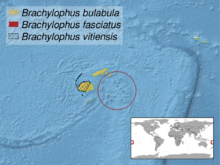Brachylophus
| Brachylophus | |
|---|---|
 |
|
| Fiji banded iguana (Brachylophus fasciatus) in captivity | |
| Scientific classification | |
| Kingdom: | Animalia |
| Phylum: | Chordata |
| Class: | Reptilia |
| Order: | Squamata |
| Suborder: | Iguania |
| Family: | Iguanidae |
| Genus: |
Brachylophus Cuvier, 1829 |
| Species | |
|
Brachylophus bulabula |
|
 |
|
Brachylophus bulabula
Brachylophus fasciatus
Brachylophus vitiensis
†Brachylophus gibbonsi
For the dinosaur, see Brachylophosaurus
The genus Brachylophus consists of three extant iguanid species native to the islands of Fiji and a giant extinct species from Tonga in the South West Pacific. One of the extant species, B. fasciatus, is also present on Tonga, where it has apparently been introduced by humans.
The name, Brachylophus, is derived from two Greek words: brachys (βραχύς) meaning "short" and lophos (λόφος) meaning "crest" or "plume", denoting the short spiny crests found along the backs of these species.
Brachylophus species are the most geographically isolated iguanas in the world. Their closest extant relatives (the genera Amblyrhynchus, Conolophus, Ctenosaura, Cyclura, Iguana and Sauromalus) are present in primarily tropical regions of the Americas and islands in the Galápagos and Lesser and Greater Antilles. Several of these genera are adapted to xeric biomes. The location of members of Brachylophus, so distant from all other known extant or extinct iguanids, has long presented a biogeographical enigma.
...
Wikipedia
